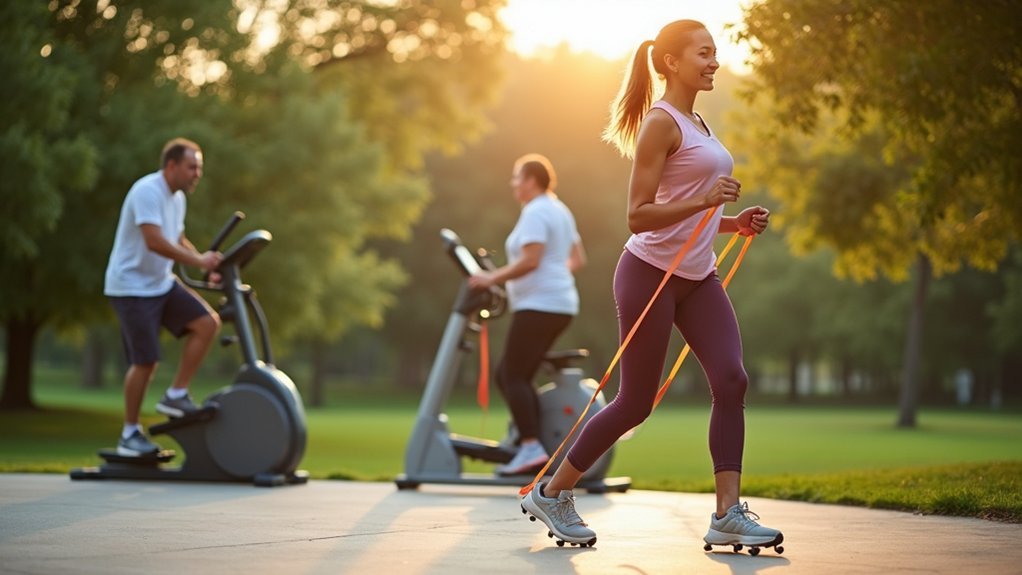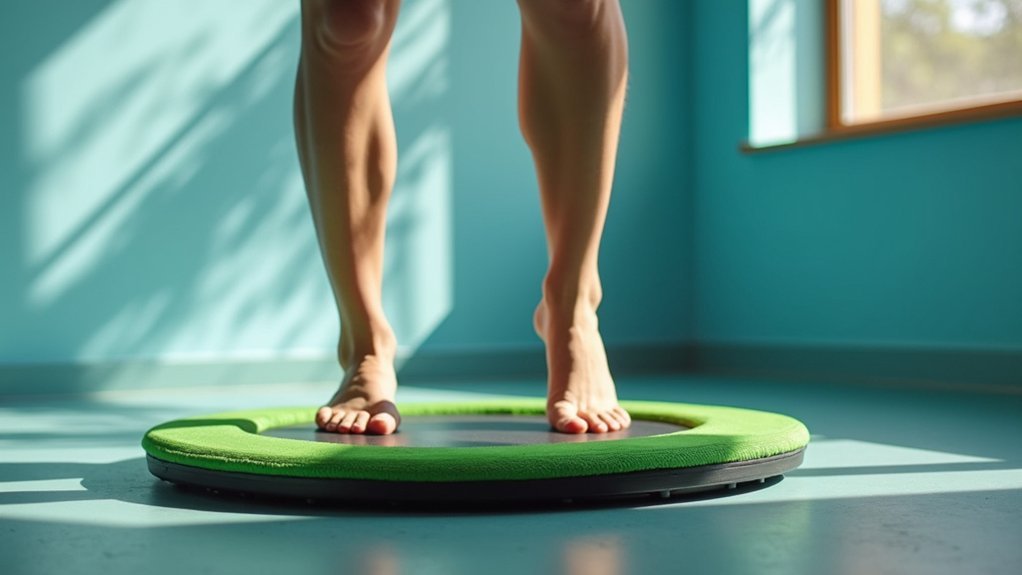Low-impact cardio is safer for your knees because it minimizes ground reaction forces and eliminates jolting impacts. These exercises distribute weight evenly throughout your body while maintaining continuous ground contact. Activities like rebounding can reduce knee stress by up to 80% compared to hard-surface workouts, as elastic surfaces absorb and redirect force away from joint structures. You’ll also benefit from increased synovial fluid production, which naturally lubricates your joints. Discover how proper technique can further enhance these protective benefits.
The Biomechanics Behind Low-Impact Joint Protection

While many fitness enthusiasts focus solely on calorie burn, the biomechanics of exercise can make all the difference for your knees’ long-term health.
When you choose a low-impact cardio workout, you’re greatly reducing stress on the knees by minimizing ground reaction forces that typically occur during high-impact activities.
The smooth, controlled movements of exercises like swimming, cycling, and elliptical training prevent sudden twists and jerks that often lead to knee problems.
These activities maintain continuous ground contact, eliminating the jolting impacts that damage cartilage and ligaments. Additionally, they help improve muscle strength around the knee joint, enhancing stability and proper alignment.
You’ll also benefit from increased synovial fluid production, which lubricates your joints and reduces joint pain while still supporting your cardiovascular health.
How Rebound Exercises Distribute Force Away From Knees
Rebound exercises like trampolining create a unique shock absorption system that reduces knee stress by up to 80% compared to hard-surface activities.
Your body experiences decreased gravitational forces when bouncing, allowing the elastic surface to absorb and distribute impact away from your vulnerable knee joints.
You’ll engage multiple muscle groups simultaneously while the springy surface handles the mechanical work of cushioning landings, making it an ideal option if you’re concerned about knee health.
Shock Absorption Mechanics
Unlike high-impact activities that can damage joints, rebound exercises effectively redirect force away from vulnerable knee structures through sophisticated shock absorption mechanics.
When you use an elliptical machine, you’ll experience fluid motion that creates smoother shifts and minimizes jarring impacts on your knees.
Low-impact exercises engage larger muscle groups that absorb impact forces before they reach your knees, distributing your body weight more evenly across joints. This redistribution can reduce injury risk by up to 50% compared to high-impact workouts.
The stress on the joints decreases notably when you incorporate supportive equipment like cushioned mats or proper footwear, which provide additional padding to dissipate force.
These shock absorption principles explain why activities such as swimming and cycling are particularly beneficial for maintaining knee health while still delivering effective cardio benefits.
Weight Distribution Benefits
The mechanics of weight distribution represent a key advantage of rebound exercises for protecting vulnerable knee joints. When you engage in low-impact cardio activities like rebounding, force disperses evenly throughout your body rather than concentrating on your knees. This balanced distribution considerably reduces stress on your knees while still providing effective cardiovascular benefits.
Your exercise regimen benefits from the trampoline or rebounder’s elastic surface, which absorbs shock and redirects impact away from knee joints. This natural cushioning effect lowers your center of gravity, minimizing joint strain during movement.
Additionally, these exercises promote muscle strengthening around the knees, creating better support and stability. Maintaining proper form during rebounding guarantees ideal weight management across your lower body and core, preventing unnecessary pressure on knee structures while improving joint health through enhanced circulation.
Building Cardiovascular Stamina Without Joint Stress

You can build impressive cardiovascular stamina through low-impact exercises that provide sustained effort without the joint stress of high-impact activities.
The heart-knee connection works synergistically when you choose workouts like swimming or cycling, which maintain your target heart rate while protecting vulnerable knee structures.
Start with shorter sessions and gradually increase duration and intensity, allowing your body to adapt while developing endurance that supports both heart health and knee function.
Sustained Effort, Less Impact
Building cardiovascular fitness doesn’t have to come at the expense of your knees. Low-impact cardio exercises like swimming and cycling allow you to maintain sustained effort while minimizing the stress on your knee joints.
You’ll still experience the same calorie-burning benefits as higher-impact workouts, but without the jarring motions that can trigger pain.
When you engage in these gentler exercises, you’re improving blood circulation and oxygen delivery to your muscles, which supports recovery and joint health.
The beauty of low-impact cardio is that you can gradually build endurance without worrying about knee pain interrupting your progress.
You’ll find yourself able to exercise longer, pushing your cardiovascular system while protecting your joints. This balanced approach guarantees you don’t sacrifice fitness for comfort.
Heart-Knee Connection Explained
Understanding how cardiovascular exercise affects your knees reveals why low-impact options matter so much for joint health. When you choose exercise that focuses on reducing joint stress, you’re building cardiovascular fitness while protecting your knees.
| Exercise Type | Joint Impact | Benefits |
|---|---|---|
| Swimming | Minimal | Enhanced muscle strength without knee pain |
| Cycling | Low impact | Improved joint stability and heart health |
| Elliptical | Controlled | Cardiovascular fitness with reduced stress |
Your heart doesn’t need high-impact movement to get stronger—it needs sustained effort. By engaging large muscle groups through smooth, controlled motions, you’ll meet the recommended 150 minutes of weekly activity while strengthening the muscles supporting your knees. Always consult your healthcare provider before starting any exercise program, especially if you have existing knee issues.
Progressive Endurance Training
While many fitness enthusiasts believe cardiovascular training requires high-impact movements, progressive endurance training proves this assumption wrong. You can build impressive cardiovascular stamina while protecting your knees through gradual intensity increases in low-impact cardio exercises.
Swimming, cycling, and elliptical training provide continuous movement without the joint stress that running creates. By incorporating variety in your routine, you’ll prevent overuse injuries while still meeting the American Heart Association’s recommendation of 150 weekly minutes of moderate activity.
The key to successful progression lies in monitoring body response during workouts. If you experience knee pain, simply adjust your intensity or switch activities.
This adaptive approach guarantees you’ll continue building endurance without compromising joint health—allowing for sustainable fitness that supports rather than damages your knees.
Proper Rebounding Techniques For Maximum Knee Safety

When jumping on a rebounder, proper technique becomes your knees’ best defense against injury and strain. By maintaining a soft landing through slightly bent knees, you’ll maximize shock absorption and protect your joints during each bounce.
Proper knee technique isn’t optional—it’s your ticket to pain-free rebounding and long-term joint health.
Engage your core consistently to improve stability while keeping your feet hip-width apart for even weight distribution.
For ideal knee safety while rebounding, follow these essential steps:
- Land with slightly bent knees to create a cushioned impact
- Keep your core engaged throughout your entire workout
- Position feet parallel and hip-width apart to prevent lateral stress
- Gradually increase intensity as your body adapts to the exercise
Choose a rebounder with adequate cushioning to create a safe workout environment that further reduces impact stress on your knees.
Comparing Impact Forces: Rebounding vs. Traditional Cardio
The numbers tell a compelling story about why rebounding has gained popularity among those with knee concerns. When you participate in rebounding exercises, the impact forces are distributed more evenly throughout your body, reducing concentrated stress on your knees by up to 50% compared to traditional cardio activities like running.
This significant reduction in joint strain doesn’t compromise your cardiovascular benefits. While running and other high-impact exercises concentrate force on knee joints, potentially leading to pain over time, rebounding offers a gentler alternative.
The elastic surface of a trampoline absorbs much of the impact that would otherwise travel through your joints. Many people report lower levels of knee pain with low-impact options, helping them maintain consistent exercise routines without the discomfort associated with high-impact activities.
Progressive Training Methods For Enhanced Knee Durability
As your knee health improves, embracing progressive training methods becomes vital for building long-term joint durability.
Start with low-impact exercises like swimming or cycling, then gradually increase intensity as your joints adapt. Consult with a healthcare professional before starting any new cardio workout regimen.
Start with gentle joint-friendly activities and progressively challenge your knees as they strengthen—always under professional guidance.
- Begin with controlled movements on equipment like ellipticals or stationary bikes to build strength while minimizing stress on knee joints.
- Incorporate low-resistance circuit training to maintain elevated heart rate while strengthening supporting muscles.
- Gradually increase duration before intensity when using progressive training techniques.
- Monitor your form constantly during exercises—proper technique guarantees you’re strengthening the right muscles without compromising knee stability.
Frequently Asked Questions
What Is the Lowest Impact Cardio for Knees?
Swimming is your lowest impact cardio option for knees. You’ll enjoy full-body exercise while water’s buoyancy reduces joint stress. Water aerobics, cycling, elliptical training, and Tai Chi are also excellent alternatives.
Which Cardio Machine Has the Least Impact on the Knees?
The elliptical machine has the least impact on your knees. You’ll experience about 60% less joint stress than treadmill running, while still getting an effective cardio workout without compromising your knee health.
What Cardio Protects Your Knees?
Swimming, cycling, elliptical training, and water aerobics protect your knees by minimizing joint impact. You’ll strengthen surrounding muscles while enjoying full range of motion without the harsh pounding of high-impact exercises.
How Can I Run With Less Impact on My Knees?
To run with less impact on your knees, choose softer surfaces, wear supportive shoes, increase mileage gradually, strengthen your leg muscles, and adopt a midfoot striking technique rather than landing on your heels.
In Summary
You’ve now discovered why low-impact cardio, especially rebounding, protects your knees while delivering cardiovascular benefits. By distributing forces evenly and reducing impact, you’re building strength without the wear-and-tear of traditional exercises. When you practice proper technique and progress gradually, you’ll develop not only heart health but also more resilient knee joints. Your journey to fitness doesn’t have to come at your knees’ expense.





Leave a Reply